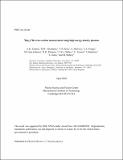| dc.contributor.author | Zylstra, A.B. | en_US |
| dc.contributor.author | Herrmann, H.W. | en_US |
| dc.contributor.author | Kim, Y.H. | en_US |
| dc.contributor.author | McEvoy, A. | en_US |
| dc.contributor.author | Frenje, Johan A. | en_US |
| dc.contributor.author | Gatu Johnson, Maria | en_US |
| dc.contributor.author | Petrasso, Richard D. | en_US |
| dc.contributor.author | Glebov, V.Yu. | en_US |
| dc.contributor.author | Forrest, C. | en_US |
| dc.contributor.author | Delettrez, J. | en_US |
| dc.contributor.author | Gales, S. | en_US |
| dc.contributor.author | Rubery, M. | en_US |
| dc.date.accessioned | 2025-03-21T20:20:57Z | |
| dc.date.available | 2025-03-21T20:20:57Z | |
| dc.date.issued | 2020-04 | |
| dc.identifier | 20ja040 | |
| dc.identifier.uri | https://hdl.handle.net/1721.1/158700 | |
| dc.description | Submitted for publication in Physical Review. C, Nuclear physics | |
| dc.description.abstract | An absolute cross section for the radiative capture reaction 2H(p, γ ) 3He has been measured at the OMEGA laser facility using inertially confined plasmas. These high-temperature plasmas are created by imploding a fuel containing capsule using laser ablation, and are advantageous in that they better mimic astrophysical systems. We measure an S factor for this reaction of 0.429 ± 0.026stat ± 0.072sys eV b at Ec.m. = 16.35 ± 0.40 keV, which is higher than the adopted evaluations. This reaction is important as a source of nuclear energy in protostars and brown dwarfs. It is also a critical reaction during big-bang nucleosynthesis, and an accurate cross section can be used as a constraint on cosmology. | |
| dc.publisher | APS | en_US |
| dc.relation.isversionof | doi.org/10.1103/physrevc.101.042802 | |
| dc.source | Plasma Science and Fusion Center | en_US |
| dc.title | 2H(p, gamma) 3He cross section measurement using high-energy-density plasmas | en_US |
| dc.type | Article | en_US |
| dc.contributor.department | Massachusetts Institute of Technology. Plasma Science and Fusion Center | |
| dc.relation.journal | Physical Review. C, Nuclear physics | |
